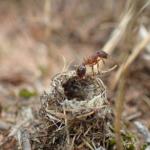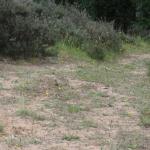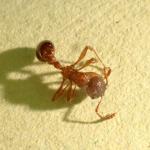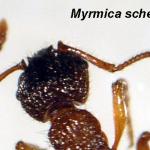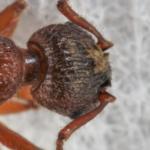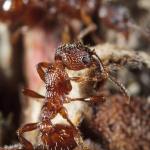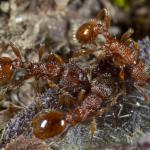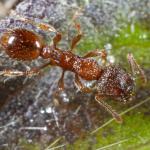Myrmica schencki was added to the British list by Donisthorpe (1915) from Welsh specimens initially thought to be M. lobicornis. Workers and queens of both of these species have the antennal scape sharply angled at the base, with this bend bearing a broad upright flange. However, in M. schencki this flange is more strongly developed, with the width across the frontal lobes consequently smaller (e.g. Seifert 1998; Bolton 2005; Pontin 2005).
In Britain, records are restricted to southern England and south Wales, and north to south Lincolnshire. Myrmica schencki also occurs in southern Ireland. A transpalaearctic species, its European range extends as far north as southern Norway, Sweden and Finland, and from Spain to Italy in the south. In Asia it extends to North Korea in the east, with its southern limit crossing the Tien Shan and central Kazakhstan (Czechowski, Radchenko & Czechowska 2002).
Not mentioned in Shirt (1987) but given as Notable B (Nb) by Falk (1991) (now known as Nationally Scarce (Nb)). Although heightened recording effort during the last 25 years or so has resulted in records from many additional 10km grid squares, particularly in south-east England, M. schencki continues to warrant Nationally Scarce status.
A warmth-loving species that is usually found among sparse vegetation or in short turf on hot, dry, sheltered sites, including dunes, cliffs, unimproved pasture and downland, heaths, banks and railway cuttings.
Nests contain winged sexuals by the end of July and during August, with mating flights occurring in August. Swarms have been observed congregating on raised ground or around tall buildings before mating pairs fall to the ground. Mating may also take place on the round near the nest (Donisthorpe 1927; Collingwood 1979; Pontin 2005; Seifert 2007).
Nests are built usually in soil but occasionally in grass tussocks. Jensen (1981) reports a nest density of 0.13 per sq. m. from Denmark. A study of the same population by Elmes & Abbott (1981) found that nests have less than 1000 workers (mean number 354) and appear to be typically monogynous. However, since newly fertilized queens may be accepted into mature queenright colonies, nests with several fertilized queens can occur. In common with some other Myrmica species, both queens and workers of M. schencki lay trophic eggs (i.e. eggs with no embryo that are consumed shortly after being laid).Workers can live for up to three years in captivity and lay male eggs throughout their lives (Wardlaw & Elmes 1995, 1998).
Although M. schencki is frequently active at night (Collingwood 1979; Seifert 2007), Jensen (1981) notes that the species is predominantly diurnal in Denmark, with workers foraging on average over an area of about 9m2. Myrmica schencki is predatory, with other ants forming a major part of its diet, but it also exploits the nectaries of various herbs, and foragers may be found among aphids on tall herbs and on shrubs (Seifert 1998; zechowski, Radchenko & Czechowska 2002; Pontin 2005).
2006


